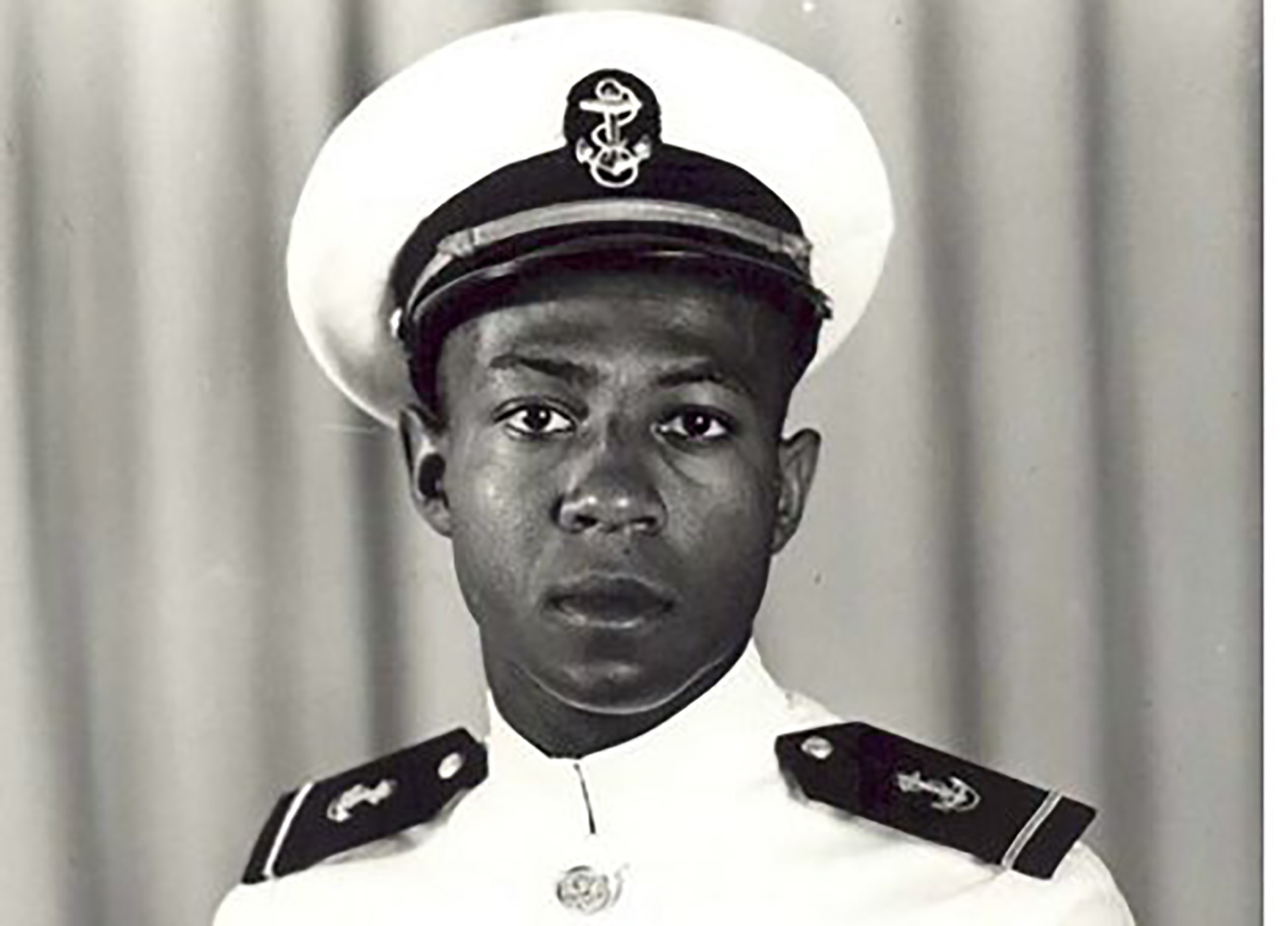By David Robinson
I would like to shed some light upon a hero, patriot, and pioneer who is virtually unknown with the exception of us diehard aviation buffs. Ensign Jesse Leroy Brown, USN, was the first black naval aviator in the United States Navy and flew and fought in the Korean War. Unlike the Tuskegee Airmen of WWII fame, Jesse underwent his odyssey alone right after WWII in the middle of deep-seated prejudices and Jim Crow. I need not tell anyone of a certain age, black or white, what that was like. Indeed, recent events involving the black experience with law enforcement demonstrate how close to surface racial issues still run in the United States. In the late 1940s, those issues were front and center, and Jesse Brown took them head-on.
Jesse was born into a sharecropper’s family in Hattiesburg, Mississippi in the year 1926. An outstanding student and athlete, he graduated from high school in 1945 with honors. Jesse chose to attend Ohio State University majoring in architectural engineering. Always interested in aviation, Jesse tried to join the OSU aviation program but was excluded because of his race. However, the Navy had an aviation cadet program that Jesse qualified for and was able to join, becoming a Navy ROTC cadet despite the sometimes vitriolic hostility demonstrated by some of the instructors. Jesse persevered and earned his Navy wings and was commissioned as an ensign in 1949, helping to break the rigid color barrier of the Navy further. Jesse was assigned to Fighting Squadron 32 (VF-32) aboard the carrier USS Leyte. VF-32 operated the F4U Corsair which during WWII was a superb air superiority fighter. By the 1950s jets had become the prevailing fighter aircraft, and prop airplanes like the Corsair were utilized in close air support of the ground troops, dropping bombs and strafing enemy infantry with the six machine guns (later cannons) mounted in the Corsairs wings.
Jesse got along well with his squadron mates and became known as a ‘good stick’, in other words, a good pilot. He and his wife Daisy and infant daughter Pamela relocated to Quonset Point, Rhode Island where VF-32 was based. Jesse also met someone who would play a critical role in his life, LT(jg) Tom Hudner.
Hudner was from a wealthy New England family and was in the Navy during WWII. Bored with the duties aboard surface ships, Hudner allowed himself to be talked into applying for aviator training despite not having much interest in flying. Hudner and Brown became good friends once introduced, and Hudner was assigned as Jesse’s wingman with Jesse becoming a section leader. In December of 1950 VF-32 was part of the USS Leyte’s air wing and sailed to Korea as part of Task Force 77. VF-32 immediately began flying ground support missions to cover UN infantry in the battle of the Chosin Reservoir.
It was at the Chosin Reservoir that China became involved on the side of North Korea, invading with enough troops that the UN was forced to withdraw from the Chosin. The cold was so severe that the reservoir was frozen solid enough and could easily support tanks, trucks, and troops. US Marine and Army infantry found themselves cut off and isolated by the overwhelming number of Chinese infantry and were forced to engage in brutal hand to hand fighting. VF-32 was flying an armed reconnaissance mission over the reservoir and surrounding snow-covered mountains when Jesse radioed that he had been hit from ground fire.
Hudner observed and reported to Jesse that the Corsair was trailing vapor from the engine which quickly stopped operating. Without power, Jesse could neither climb over the mountains to friendly territory nor bailout. His only option was a wheels-up forced landing at the first opportunity. With Hudner’s help, Jesse picked a place that was sloping up to a snow-covered mountainside. Jesse and Hudner went over the checklist to make a forced landing and Jesse’s airplane began sliding uphill; doing well until suddenly Jesse’s airplane pitched up tail first and sideways, losing part of a wing and bending the fuselage in half and knocking the engine loose from its mounts. He had hit a huge boulder hidden in the snow. Jesse’s squadron flew over the smoking wreck in stunned silence, thinking to a man that Jesse had just died. Then the canopy slid back, and an arm shot up from the cockpit.
Jesse was still alive! They tried reaching him over the radio without success as Jesse’s radio had been destroyed in the crash. Nor did Jesse try to leave the cockpit despite the increasing amount of smoke coming from the engine. It became apparent that Jesse was unable to get out, and Tom Hudner became horrified at the thought of Jesse burning alive. Hudner pressed the transmit button for his radio and said: “I’m going in.â€
Hudner picked a place about a hundred yards from Jesse and once stopped unstrapped and began nearly an hour-long slog through chest-deep snow to Jesse. Hudner started packing snow into the cowling surrounding the engine to put out the fire, burning his hands in the process. Unable to put out the fire, Hudner climbed on the Corsair’s wing and leaned in to see Jesse’s ashen face. Jesse had lost his helmet, and his hands were bare from removing his gloves to unfasten the seat harness. Jesses said, “I’m trapped, Tom, and I can’t get out.†Hudner got behind Jesse and grasping him under the arms pulled with all he had, but Jesse just groaned in pain and did not budge. Jesse was really trapped in that airplane. Hudner put an extra stocking cap he had on Jesse’s head and wrapped his frozen hands in a scarf and told Jesse he had to go back to his airplane to radio for a rescue helicopter. Jesse nodded, and Hudner radioed that the helicopter needed to bring an axe and fire extinguisher. Hudner then went back to Jesse and did what he could to try to comfort his friend and extricate him from the wreck.
Hudner noted that Jesse was extremely calm despite being in what had to be terrible pain. Jesse never complained, never said ‘why me’ and soon began to lose consciousness from a few seconds to a few minutes. Finally, the clatter of rotor blades could be heard over the sound of the VF-32 flying cover. The small helicopter landed and Marine Lt. Charlie Ward jumped out with a fire extinguisher and fire axe.
Hudner and Ward could not put out the engine fire despite the extinguisher, and for nearly an hour they took turns trying to open a hole in the Corsairs fuselage to free Jesse. All they managed to do was scratch the paint. They both tried lifting Jesse out but were unsuccessful. They even discussed cutting Jesse’s trapped leg off with a knife, but could not bring themselves to do that, either. The sun was beginning to set; VF-32 had to withdraw due to low fuel, encroaching darkness, and no more ammunition. Ward looked at Hudner and said, “We have to go.†Helicopters in 1950 did not have the ability to fly at night safely. Nor would the engine operate at the insanely low temperature that would occur that far north.
Tom Hudner told Jesse, “We have to go now, Jesse. We’ll be back in the morning to get you.†Jesse knew better and said softly, “Tom, if I don’t make it, tell Daisy I love her.†Jesse lost conciseness and died shortly thereafter from the injuries received in the crash. Ward and Hudner made it back to an allied airfield and the next day flew back to the Leyte where Hudner recounted to the ship’s captain and other high ranking officers what had transpired.
The next day with Jesse being dead and behind enemy lines, VF-32 flew to the wreckage of both Corsairs’s and dropped napalm on them to deprive the enemy of any way to exploit Jesse Brown and the weapons aboard the aircraft. The pilots of VF-32 said aloud the Lord’s Prayer as they dropped the napalm, noting that though Jesse was still in the cockpit, his clothing was gone. The mood aboard the USS Leyte and in particular VF-32 was somber from Jesse’s loss. Jesse was not only the first black aviator in the Navy; he was the first black naval officer to be killed in combat.
Tom Hudner would meet Daisy Brown in Washington DC where Hudner was awarded the Medal of Honor for his attempt to rescue Jesse. Daisy Brown received her husband’s posthumous Distinguished Flying Cross, Purple Heart, and Air Medal from President Truman. Hudner told Daisy personally what Jesse’s last thoughts were. He would stay in contact with her for the rest of their lives. Shamefully, Daisy Brown was not allowed to remain in the same hotel as Hudner’s family despite her husband’s sacrifice in the name of freedom.
In 1973 Captain Tom Hudner spoke at the commissioning ceremony of the Knox Class Fast Frigate USS Jesse L Brown, FF-1089. Also, there was Daisy Brown Thorne, who had remarried and Pamela Brown. In his dedication, Hudner said of Jesse “He died in the wreckage of his airplane with courage and unfathomable dignity. He willingly gave his life to tear down the barriers of freedom to othersâ€.


